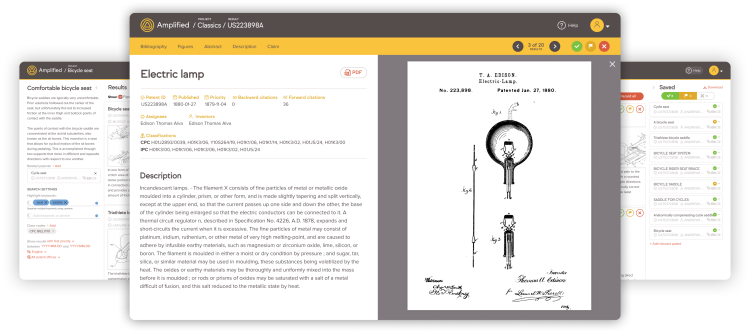blogIntroducing Amplified — Changing the patent system for good

Yesterday after three years of research and development in artificial intelligence,testing on over 1.5 million patent applications, and the contributions of nearly 600 beta users we launched the Amplified AI platform. This a paradigm shift in finding prior art that will transform patents.
The patent system is overloaded with information. Specialized patent search has become a bottleneck for the whole system and the lack of certainty in search results diverts time, money, and attention away from innovation. We have watched attorneys, inventors, and professional searchers use Amplified to change the way they interact with patents. Now we are making the Amplified platform widely available to help bring true innovations to market faster and with greater peace of mind.
This is a paradigm shift for three reasons:Finding the vast majority of patent prior art no longer requires complicated software or specialized skills
Missing prior art due to keyword queries and human error is much more difficult
Faster and easier patent prior art frees patent and search experts to focus on harder to find information and interpreting their findings
While many have tried to make prior art search more efficient, Amplified is the first in the world to enable better and more complete searches at a fraction of the time and cost. Compared to professional prior art searches which typically take four to 40 hours, most searches in Amplified are complete in under an hour and a rough search can be as short as a couple of minutes.
Instead of trying to replicate human logic, we set out to complement itThis has not been an easy journey. To be fair, we didn’t think it would be. Patent search databases and automated search solutions existed well before Amplified was founded. We know because we used them all in previous lives as professional patent searchers and experienced first-hand the waste and inefficiency. The problems have been around long enough that they are now part of the system.
Unlike the existing tools, our goal isn’t to make patent search more efficient — we’re building a systemic solution to solve a systemic problem. But until now the technology wasn’t there. Research in natural language processing (NLP), machine learning (ML), and artificial intelligence (AI) have already upended areas like legal document search and news analysis without producing similar results for patents.
Incremental change isn’t enoughTo really change patents we needed a paradigm shift. Our experience in patent search had taught us that much and from our work in artificial intelligence and data science we knew existing approaches were already nearly maxed out. The paradigm shift was going to have to come from something new, so we focused ourselves singularly on research in a new field of AI that was just emerging.
We used over 120 million patents to train an AI model to understand technology and inventiveness. No class code, citation network, or text mining shortcuts. Just holistically reading text and interpreting in the context of tens of millions of other patents around it. The results exceeded our wildest expectations.
But that wasn’t enough. Searching is an iterative process. There’s not a magic button to always find exactly what you’re looking for because often what you are looking for depends on what you find. And not everyone is looking for the same thing every time. We wanted power, flexibility, and control — a way of partnering with AI to empower you.
Here it is: Amplified.No tricks or sleight of hand, no artificially limiting results with clever class code filters or keywords. Just a cutting edge machine learning model, a lightning fast search architecture, and an intuitive interface. Using it is simple. Just start writing.
Results load in seconds and update automatically as you add patents or write more
Use keyword highlights to make review easier then toggle them on and off to filter results
As you find and save relevant results Amplified learns and automatically adjusts

Amplified reduces the time needed to comprehensively identify relevant, useful patents by orders of magnitude. To confirm reliability, we tested 4.5 million known relevant patents found by expert searchers across 1.5 million filings. To determine if we could find results missed by human search we also tested against prior art that was not found during examination and successfully used to later overturn an already granted patent. In both cases we found prior art as well as the expert search and, in the case of the opposition and challenges, better. Over the past six months professional searchers, patent attorneys, and inventors verified this performance on more than 2200 examples.
The implications of making prior art this readily available are far-reaching:
Examiners can find the vast majority of relevant art up front instead of missing information because they ran out of time.
Professional searchers can finish their patent work quickly and focus on adding value instead of trawling through thousands of irrelevant patents.
Inventors and researchers at private companies can identify risks upfront before committing significant time and money to the already risky endeavor of R&D.
Attorneys who have to wait weeks for prior art results from a third-party can instead work iteratively with their clients and with the best prior art always on hand.
The patent system today, overburdened with information, is a hidden tax on innovation. Radically reducing the challenges of finding prior art is our first step towards removing that burden. We envision a future where the patent system once again functions the way it was intended — as an engine of progress, growth, and jobs.